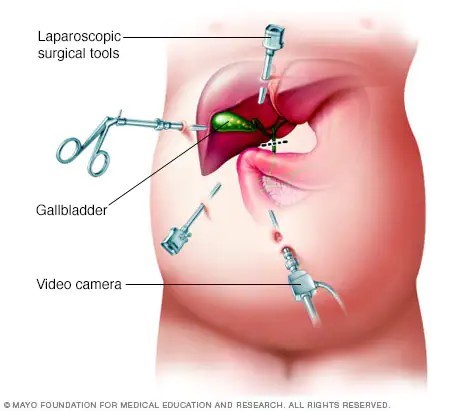A nurse is reinforcing teaching with a client who is postoperative following a laparoscopic cholecystectomy. Which of the following statements by the client indicates an understanding of the teaching?
“I should eat a high-fat diet for several weeks."
"I should expect to have diarrhea until my diet changes."
"I should expect to have nausea for several days."
"I should leave my steri-strips on until they fall off."
The Correct Answer is D
After a laparoscopic cholecystectomy, steri-strips or adhesive strips are commonly placed over the small incisions. The client should keep the steri-strips in place until they fall off on their own or until they are removed by the healthcare provider during a follow-up visit. Removing the steri-strips prematurely can increase the risk of infection or disrupt the healing process.
"I should eat a high-fat diet for several weeks": After a laparoscopic cholecystectomy, it is important for the client to follow a low-fat diet initially to allow the body time to adjust to the absence of the gallbladder. High-fat foods can be more difficult to digest and may cause digestive discomfort. Gradually introducing small amounts of fat back into the diet is recommended, but a high-fat diet is not appropriate.
"I should expect to have diarrhea until my diet changes": While changes in bowel movements can occur after a cholecystectomy, such as looser stools or changes in frequency, persistent diarrhea is not expected or normal. If the client experiences persistent diarrhea, they should contact their healthcare provider for further evaluation.
"I should expect to have nausea for several days": While some clients may experience mild nausea or discomfort after the surgery, it should generally improve within a few days. If the client experiences persistent or severe nausea, they should contact their healthcare provider.

Nursing Test Bank
Naxlex Comprehensive Predictor Exams
Related Questions
Correct Answer is C
Explanation
Nausea and vomiting are common side effects of doxycycline, an antibiotic commonly used to treat chlamydial infections. Taking the medication with food or a snack can help alleviate these side effects. The recommendation to take the medication with crackers provides a light source of carbohydrates that can help settle the stomach and reduce nausea.
It is generally not recommended to take doxycycline with calcium-rich foods or beverages, as they can interfere with the absorption of the medication. Calcium can form complexes with doxycycline, reducing its effectiveness. Therefore, it is best to avoid calcium-rich foods and beverages, including calcium-fortified orange juice, when taking doxycycline.
Similar to calcium-rich foods, antacids can also interfere with the absorption of doxycycline. Antacids contain aluminum, magnesium, or calcium, which can bind to doxycycline and reduce its effectiveness. Therefore, it is generally recommended to avoid taking doxycycline with antacids.
While it is important to remain upright for a short period after taking some medications to prevent reflux or aspiration, this recommendation may not specifically address the client's nausea and vomiting. Taking the medication with food, such as crackers, may be more effective in alleviating the symptoms.
Correct Answer is D
Explanation
Epinephrine is a medication commonly used to treat severe allergic reactions, also known as anaphylaxis. One of the hallmark signs of anaphylaxis is difficulty breathing or shortness of breath. Epinephrine works by constricting blood vessels, relaxing smooth muscles in the airways, and reducing swelling, which can help relieve the symptoms of respiratory distress. Epinephrine is not typically used to treat nausea, hyperglycemia, or hand tremors.
Nausea can be caused by various factors and is usually managed with antiemetic medications. Hyperglycemia, which refers to high blood sugar levels, is typically managed with appropriate diabetes management, including insulin or other glucose-lowering medications. Hand tremors can have different underlying causes, and their treatment depends on the specific etiology.
Whether you are a student looking to ace your exams or a practicing nurse seeking to enhance your expertise , our nursing education contents will empower you with the confidence and competence to make a difference in the lives of patients and become a respected leader in the healthcare field.
Visit Naxlex, invest in your future and unlock endless possibilities with our unparalleled nursing education contents today
Report Wrong Answer on the Current Question
Do you disagree with the answer? If yes, what is your expected answer? Explain.
Kindly be descriptive with the issue you are facing.
